




Working Together to Support Pupils with SEMH in a Mainstream School and Classroom Setting
Written by Ruth Gately Specialist Lead Adviser, SEND
Secondary School Improvement Team




This toolkit has been created as a guide to support pupils with SEMH in the school setting.
A number of key DfE documents, research and professional bodies findings have supported the development of the toolkit which also support the eight principles to Public Health England working with the Department of Education ‘Promoting Children and Young People’s Mental Health and Wellbeing’ (2021), Kent Resilience Hub’s ‘Whole School Approach’ and KCC’s SEN Mainstream Core Standards.
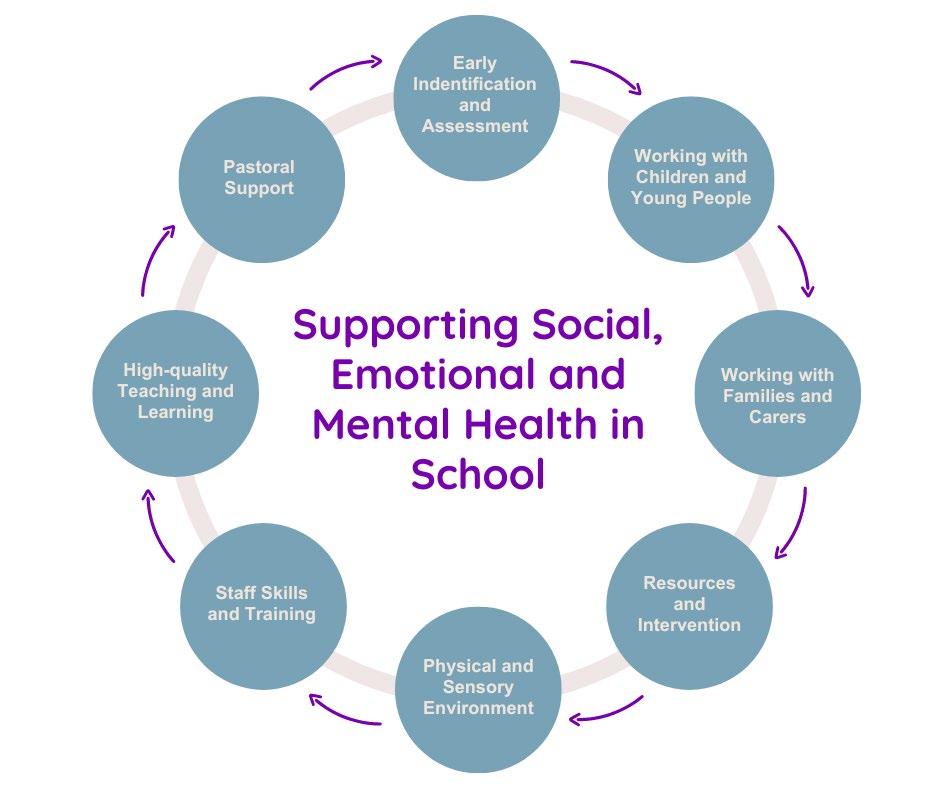


ADPR Assess- Plan – Do – Review – The Graduated Approach
AP Alternative Provision
ASC Autistic Spectrum Condition
CATIE Countywide Approach to Inclusive Education
CHYMPS Children & Young People’s Mental Health Service (previously CAMHS)
CIN Child in Need
CYP Children & Young People
DLD Developmental Language Disorder
DSL Designated Safeguarding Lead
DSLMH Designated Senior Lead for Mental Health
EBSA Emotionally Based School Avoidance
EEF Education Endowment Foundation
EH Early Help
EHCP Education, Health and Care Plan
ELSA Emotional Literacy Support Assistant
EP Educational Psychologist
HI Hearing Impaired
IASK Information Advice and Support Kent
KELSI Kent Education Learning and Skills Information
KPACT Kent Parent and Carers Together
LAC Looked After Child
MCS Mainstream Core Standards
ODD Oppositional Defiant Disorder
PD Physical Disability
PDA Pathological Demand Avoidance
SEND Special Educational Needs and Disabilities
SEMH Social, Emotional and Mental Health
SENCO Special Educational Needs Coordinator
SENK SEND support learners on the SEN register
SENIA SEN Inclusion Adviser
SLCN Speech, Language and Communication Need
STLS Specialist Teaching and Learning Service
VI Visually Impaired
VSK Virtual Schools Kent


This toolkit has been created to help educational practitioners to support pupils with SEMH to thrive in their mainstream setting – socially, emotionally, and academically. Information being communicated by headteachers, SENCOs, teachers, support staff and pastoral leads over the past year indicates that schools/academies are experiencing increasingly greater numbers and cases of pupils who have Social, Emotional and Mental Health difficulties.
The toolkit has been developed as a guide for classroom practitioners, teaching assistants and pastoral staff – it should not be used as a means to diagnose SEMH but instead: as a resource to enable a school/academy to develop their systems and processes: to identify and support pupils who are struggling with their mental health and wellbeing; and to seek the right provision whilst using the Graduated Approach –assess-plan-do-review.
It is important to note that school staff should always follow the policies and procedures relating to safeguarding and provision for pupils with special educational needs and seeking the support of key professionals when required.
To support you as a classroom practitioner there are links to key documents and websites that may provide you with more information and tools that you can adapt and employ in lessons or throughout the school day.
Where an external agency is suggested for support, you will be able to click on the link which will direct you to their website.



SEND Code of Practice January 2015.pdf
It is important to note that a pupil may have one or more identified or undiagnosed area(s) of need from the four broad areas defined below and that pupils who have a diagnosis, such as for example ASC or ADHD, can also experience SEMH difficulties too. It is expected that the majority of pupils with an EHCP will attend an inclusive mainstream school/academy, working alongside their peers, studying a mainstream, well-sequenced curriculum which, if required, will be adapted to meet their needs
The four broad areas of need defined in the SEND Code of Practice 2015:
“6.28 Children and young people with speech, language and communication needs (SLCN) have difficulty in communicating with others. The profile for every child with SLCN is different and their needs may change over time.”
“6.29 Children and young people with ASC, including Asperger’s Syndrome and Autism, are likely to have particular difficulties with social interaction. They may also experience difficulties with language, communication and imagination, which can impact on how they relate to others.” (DfE 2015:97)
‘”6.30 Support for learning difficulties may be required when children and young people learn at a slower pace than their peers, even with appropriate scaffolding. Learning difficulties cover a wide range of needs, including moderate learning difficulties (MLD), severe learning difficulties (SLD), where children are likely to need support in all areas of the curriculum and associated difficulties with mobility and communication, through to profound and multiple learning difficulties (PMLD).
6.31 Specific learning difficulties (SpLD) affect one or more specific aspects of learning. This encompasses a range of conditions such as dyslexia, dyscalculia and dyspraxia.”
(DfE 2015: 97)



“6.34 Some children and young people require special educational provision because they have a disability which prevents or hinders them from making use of the educational facilities generally provided. However, schools with the support of key professionals should be able to provide a high-quality inclusive education to meet a pupil’s needs. These difficulties can be age related and may fluctuate over time. Many children and young people with vision impairment (VI), hearing impairment (HI) or a multi-sensory impairment (MSI) may/will require specialist support and/or equipment to access their learning, or habituation support.”
(DfE 2015:98)
SEMH is identified as one of the four areas of need in the SEND Code of Practice 2015 defining social, emotional, and mental health difficulties as:
“6.32 Children and young people may experience a wide range of social and emotional difficulties which manifest themselves in many ways. These may include becoming withdrawn or isolated, as well as displaying challenging, disruptive, or disturbing behaviour. These behaviours may reflect underlying mental health difficulties such as anxiety or depression, self-harming, substance misuse, eating disorders or physical symptoms that are medically unexplained. Other children and young people may have disorders such as attention deficit disorder, attention deficit hyperactive disorder or attachment disorder.
6.33 Schools and colleges should have clear processes to support children and young people, including how they will manage the effect of any disruptive behaviour, so it does not adversely affect other pupils.” (DfE 2015:98)
The DfE report ‘Mental health and behaviour in schools’ stated:
“Mental health is defined as a state of wellbeing in which every individual recognises his or her own potential, can cope with the normal stresses of life, can work productively and fruitfully, and is able to make a contribution to his or her own community. World Health Organisation, August 2014” (DfE 2018: 11)
“Schools have a central role to play in enabling their pupils to be resilient and to support good mental health and wellbeing. It is important that schools promote good mental wellbeing for all pupils.



A school’s approach to mental health and behaviour should be part of a consistent whole school approach to mental health and wellbeing. This should involve providing a structured school environment with clear expectations of behaviour, well communicated social norms and routines, which are reinforced with highly consistent consequence systems. This should be paired with an individualised graduated response when the behavioural issues might be a result of educational, mental health, other needs, or vulnerabilities.” (DfE 2018: 4,5)
Special Educational Needs and Disabilities (SEND) and Alternative Provision (AP) Improvement Plan stated:
“Providing mental health support to children and young people: Meeting children’s social, emotional, and mental health (SEMH) needs is a crucial aspect of strong SEND provision. Schools and colleges play a vital role in promoting and supporting pupil and student mental health and wellbeing. They work to create safe, calm, supportive and inclusive environments, tackle bullying and teach pupils and students about their mental health and about when to ask for help. Through daily interactions, staff can validate children’s feelings, boost their confidence, and increase their resilience. Many education settings also offer targeted support, for example through play therapy or counselling or a nurture or social skills group.” (DfE 2023: 65)
Following the COVID-19 pandemic the report ‘Promoting children and young people’s mental health and wellbeing – A whole school or college approach’ acknowledged that:
“Schools and colleges have an important role to play in supporting the mental health and wellbeing of their pupils and students, by developing approaches tailored to the particular needs of their pupils and students. Taking a coordinated and evidenceinformed approach to mental health and wellbeing in schools and colleges can also help foster readiness to learn.” (PHE/DfE 2021: 5)
Supporting pupils with SEMH is everyone’s responsibility, however schools are not in a position to, nor should they act as mental health experts and diagnose conditions - that is not their remit. What is important is that all staff have a knowledge and understanding of their school systems and protocols that are in place to help support the early identification of pupils who may require SEMH support.
Mental health and behaviour in schools (publishing.service.gov.uk)



The role of the SENCO is to collaborate with all staff to strategically collate the early identification and assessment tools, resources and interventions and key strategies that will support pupils in the school environment to enable them to thrive socially, emotionally, and academically. Providing high-quality training is essential to ensure that SEMH provision is consistently embedded in the classroom to support pupils’ mental health and wellbeing. Knowing your pupils well is paramount.
Speaking to your curriculum leads and the SENCO about concerns and seeking advice is important in ensuring that you are provided with the most appropriate support and strategies. Communicating your observations and key information is also vital to guarantee high-quality provision for every pupil in your class and school.
SEND Code of Practice 2015: Assess – Plan – Do – Review (APDR) SEND Code of Practice January 2015.pdf
Irrespective of a pupil’s need, the Graduated Approach is a key process to support all aspects of SEND provision. It enables the SENCO to effectively collaborate with teachers, the form tutor, pastoral lead, and teaching assistants
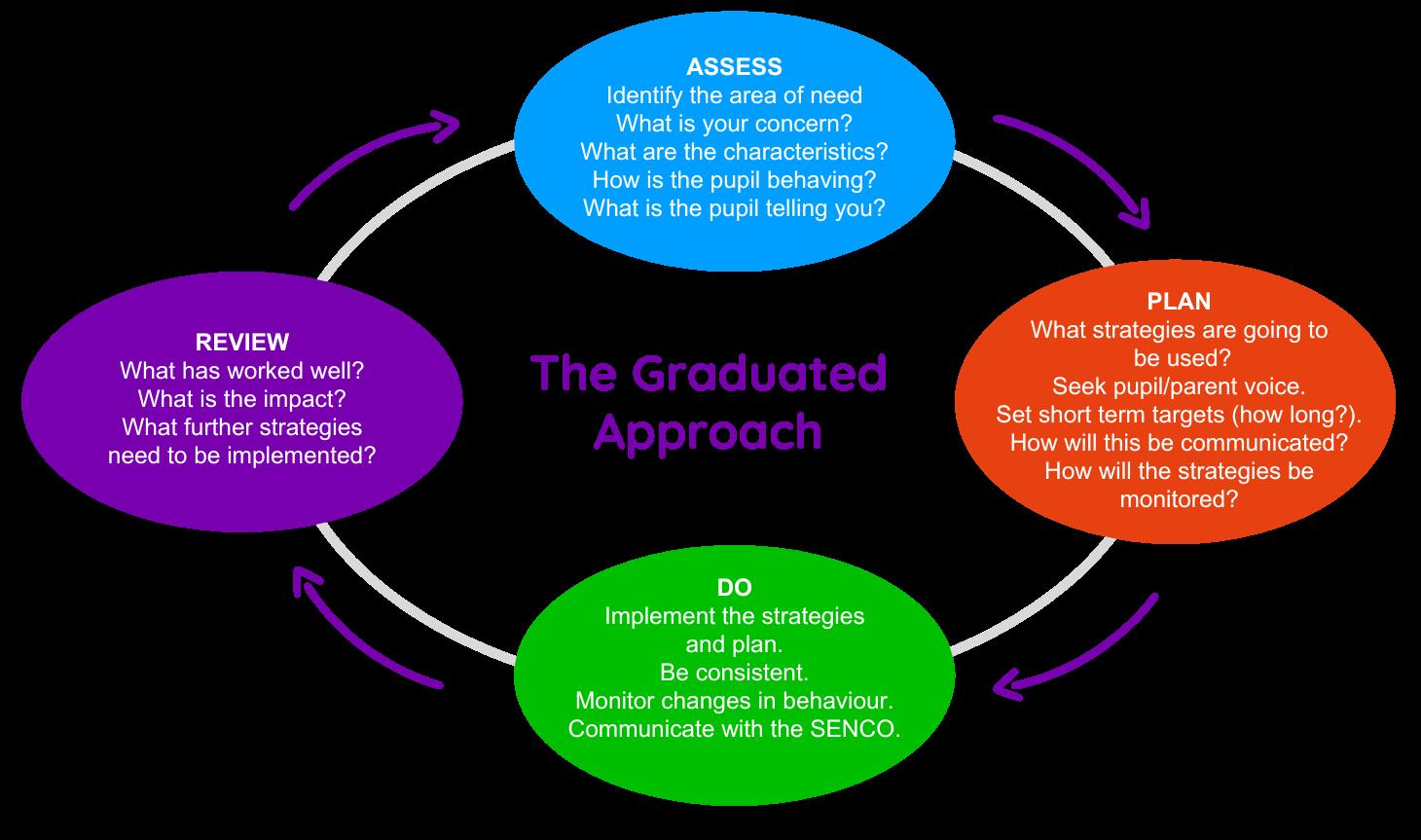


Three cycles of the Graduated Approach are recommended for each pupil on the SEND register and is a legal requirement for pupils with an EHCP to ensure that there has been a clear plan and implementation of provision which has been carefully monitored and reviewed. All school practitioners must work closely with the SENCO to guarantee that the school has undertaken their ‘best endeavours’ to support the pupil.
The Graduated Approach will provide clear evidence to enable the SENCO to access key professional support via local networks or referrals if all the school strategies and interventions have been exhausted and the pupil continues to struggle to access their school environment and education. However, if the pupil’s SEMH needs escalates and interventions/strategies do not have an impact prior to completing the three cycles, the SENCO will be able to and should/must seek more immediate support through referrals to safeguarding protocols and referrals to key agencies and professionals.
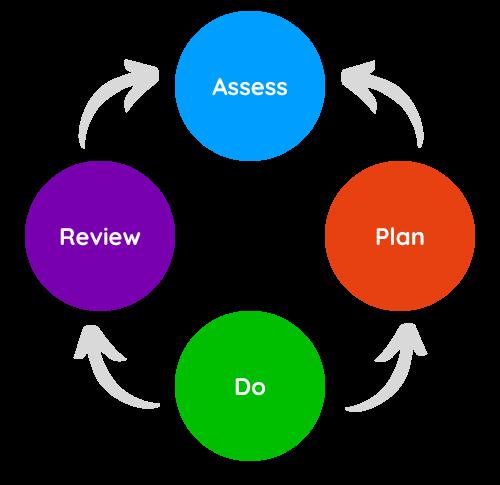
“3.24 Early intervention to address underlying causes of disruptive behaviour should include an assessment of whether appropriate provision is in place to support any SEN or disability that a pupil may have. The head teacher should also consider the use of a multi-agency assessment for a pupil who demonstrates persistent disruptive behaviour. Such assessments may pick up unidentified SEN, disability, or mental health problems but the scope of the assessment could go further, for example, by seeking to identify housing or family problems.


3.25 Not all children with mental health difficulties will have SEN. But persistent or serious mental health difficulties will often meet the definition of SEN, in that they lead to pupils having significantly greater difficulty in learning than the majority of those of the same age. As set out above, the graduated response process set out in the SEND Code of Practice provides a framework for deciding what support to offer, which would be good practice regardless of whether a pupil has SEN.” (DfE 2018: 19,20)
Schools can use existing systems to identify if a pupil is causing concern and is at risk of developing mental health problems.
Quantitative data – grades and other numerical data:
changes in the pupil’s level of attainment
the pupil is accruing increasing numbers of behaviour logs
attendance levels are dropping, or patterns of absence are emerging
school refusal – parents report high levels of anxiety.
Qualitative data - from observations and verbal feedback from subject teachers, teaching assistants, pastoral staff (including form tutors) and other pupils are reporting changes in a pupil’s behaviour. Here are some examples.
Pupil is becoming increasingly withdrawn (unwilling to contribute or interact with their peers in class or during break and lunchtime).
Pupil is becoming more vocal, and behaviours do not reflect their usual personality traits.
Pupil is being sent out of their lessons due to their disruptive behaviour.
Pupil displaying risky behaviours.
Pupil is withdrawn from peer/friendship group.
Safeguarding concerns are raised in line with school systems and protocols (safeguarding policy).
Pupil reports they are not sleeping well.
Pupil is not coping with transition and change.
Visible changes to a pupil’s appearance, facially and/or physically.
The Mainstream Core Standards provide guidance to support schools in the eight areas highlighted at the start of the toolkit.



Mainstream Core Standards - Assessment (page 8)
A regular cycle of Assess, Plan, Do, Review is used to ensure that pupils with SEND are making progress.
Pupils complete a pupil voice confidence questionnaire. See examples in Working with Children and Young People section 2.
Pupils’ strengths and difficulties in learning, communication, and social and emotional development are observed and monitored in different settings and contexts to inform planning.
Staff are aware of pupils’ starting points so that expected progress can be measured across each key stage.
Assessment is used to inform planning and interventions. Boxall profile, strengths, and difficulties questionnaires.
Consideration is given for individual pupils’ developmental profile and holistic progress.
Discuss the pupils through access to local networks (SENCO).
The school can seek advice and guidance to support the pupil from professional services such as the Specialist Teaching and Learning Service or School Public Health Service with parent/carer consent.
Should a member of staff be concerned they should always inform and seek advice from SENCO and Pastoral Leads/designated member of staff.
Practitioners ensure that formative assessment and feedback are a feature of lessons and evident in marking and assessment policy.
A wide range of assessment strategies and tools are used to ensure a thorough understanding of the whole child or young person.
Pupils have regular opportunities to evaluate their own performance. Self-assessment is routinely used to set individual targets.
The impact of interventions is critically evaluated by the SENCO or key professional.


Alternative approaches are explored to establish whether they may result in better outcomes for the learners.
Supporting pupils with SEMH in tests and public examinations.
SENCO must ensure that evidence is collected and collated.
Settings make adaptions to assessment arrangements as part of their everyday practice. This is used to establish the learner’s normal way of working.
Schools refer to the relevant exam board guidelines. Arrangements could include:
• rest breaks
• use of a reader/scribe/laptop
• extra time adapted resources are used in class and assessments.
A possible document that can support the early identification of need and supports the graduated approach is to complete a 360 Behaviour for Learning Support Document which seeks to collate all the information a SENCO and Pastoral Lead will require to identify:
• What are the potential factors that are driving a pupil’s behaviour?
• What external factors may be contributing to the pupil’s behaviour?
• What support and intervention could be provided to improve outcomes for the pupil?
Once a pupil has been identified as a cause for concern regarding their presenting behaviours the SENCO or Pastoral Lead/designated member of staff should seek to gain as much information and detail as possible from teachers, support staff, pastoral staff, and other professionals (if they are already working with the pupil) in the following areas:



Overall observations and concerns identified.
Social presenting factors and observations.
Intervention and support already in place and any professional involvement.
Curriculum – academic progress. Known family/home circumstances and factors that may be impacting on the pupil’s current academic, social, and emotional outcomes.
Emotional presenting factors and observations.
Ask the pupils to complete a pupil confidence questionnaire to ensure their voice is sought, which could identify key areas of concern for the pupil and changes in classroom practice that might need to be reviewed.
Having gathered all the relevant information for colleagues – arrange a meeting to discuss the document and identify which is the area of need that is having the greatest impact upon the pupil’s SEMH.
During the meeting populate the planning recommendation form creating a clear plan as to what strategies need to be put in place to support the pupil at this stage. It is advisable to invite parents/carers to the meeting and involve them in the development of the plan. It is also important that the pupil’s voice is sought and whenever possible they are invited to be involved in the meeting either the whole meeting or part of the meeting especially where strategies are being discussed.
A review date must be set at the planning meeting so that a clear time scale and SMART strategies and targets are set.
Following the meeting it is advised to arrange a meeting with the pupil’s teachers to inform and share with them the current needs of the pupil and the agreed strategies and targets that have been set – this will ensure continuity and clear lines of communication.
Learning walks and check-ins with the pupil should take place during the ‘DO’ phase.
Following the agreed DO period, the review meeting should take place on the pre-arranged date. The SENCO and/or the pastoral/designated lead should again seek the views of



members of staff and professionals who contributed to the ASSESS stage. All feedback should be linked to the original collation of information and referenced in conjunction with the targets and strategies agreed.
During the meeting with parents and the pupil all aspects of the plan should be discussed and reviewed – positive outcomes and areas to continue to develop.
The meeting may require a second cycle of ASSESS – PLAN – DO – REVIEW using and updating the documentation.
Through the completion of the documentation the SENCO will be able to evidence the ‘best endeavours’ to support the pupil and can be used to support referrals to local networks, Specialist Teaching and Learning Service, School Public Service or other key professionals who support pupils with SEMH.


Pupil: Year group:……
Completed by: SENCO……………………
Pastoral/designated lead ………………………...
SEND Register: Yes / No
Date: …………..
What are the behaviours they exhibit that are causing concern? (What is it that the pupil does or does not do that is causing problems?) What concerns have staff raised? How long has their presenting behaviour being going on?
SEND confirmed diagnosis: ……………………
What support/intervention is already in place or implemented previously? External agencies/professionals
Curriculum: Outline their general aptitude as a learner in lessons and their attitude to learning and behaviour when taking part in learning activities. What are they good at, what do they struggle with, what is their progress like? Current classroom provision in place e.g., TA support. Does the pupil attend interventions?
Key data: Academic starting point:
Reading age: Spelling age:
Strengths:
Areas for development:
Social: How they present socially in lessons and around the academy - how are they when taking a part in group work, what are their interactions with adults and their peers like? How do they cope with the social demands of the setting?
Please comment on family/home circumstances or external contributing factors
Emotional: How do they present emotionally? How do they respond when presented with unfamiliar or difficult tasks? Do they appear confident? How well do they manage strong emotions? What do you think their self-esteem is like? What intervention provision is currently in place?
Please comment on any relevant family circumstances or external contributing factors
Please comment on any relevant family circumstances or external contributing factors


Plan Recommendations with Pastoral, SENCO, Key Staff, Parents and Carers
Identified particular area of need – curriculum, social or emotional that needs to be strengthened.
Learning Behaviours that would expect to see improving.
Identified strategies approaches or interventions to develop targeted area curriculum, social or emotional.
Key assessable indicators that will show that strategies have had a positive effect on the target relationship.
Review date:


It is imperative that staff know their pupils well and collaborate closely with pupils seeking their voice and views to be able to fully support them in lessons – often pupils will wish to work with a trusted adult of their choice. Creating a profile of need with strategies to support a pupil with SEMH. Always follow your school’s safeguarding policy, protocols and procedures when talking to pupils.
It is important to acknowledge that pupils’ behaviour may present in a variety of ways.
Emotionally – for example, a pupil may present as: extremely anxious, withdrawn, angry, agitated, sad, annoyed, over stimulated, frightened and have heightened emotions which they find difficult to manage. Attendance may be an issue - Emotionally-Based School Avoidance. The pupil may have or be experiencing loss and bereavement. Exhibit Low self - confidence, selfbelief and self-esteem. Experience attachment and relationship difficulties.
Socially – for example, a pupil may present as: overbearing and loud, overly physical with their peers, invading other pupils’ space; or they could be withdrawn and reluctant to work with their peers or interact in the lesson, preferring to work alone. Pupils may have difficulties making and maintaining friendships. Concerns/problems/subject to bullying. May have difficulties understanding social boundaries and following rules.
Physically – for example, a pupil may present as tired, hungry, thirsty, complaining about being injured, or that their body is aching.
Educationally – pupils’ experience, self-belief and confidence will significantly impact on their engagement in lessons or certain subjects and their presenting behaviours. It is important to know their starting point, any prior educational experience to identify any knowledge gaps.
Specific diagnosed Special Educational Need it is important to seek the advice of the SENCO and employ the strategies to support individual pupils in lessons – please see the information below to support.




Cambridgeshire County Council 'Why I am rude'. video
A poem written by Sarah Dillon, National Association for Therapeutic Parents
The school will work in partnership with pupils to support their SEMH.
Pupils complete a pupil voice confidence questionnaire. See examples below.
Pupils have a designated ‘trusted adult’ that they check in with daily.
Pupils have a safe space to go to when their behaviour is heightened/have a low mood/are struggling to successful access their school day.
The school creates a toolkit for pupils to use during lessons which is communicated to staff via the pupil profile or school protocols.
Ensure whenever possible that the pupil has a trusted adult of their choice who will be their support – it is important that clear lines of communication and boundaries are set up to support this. A planned daily ‘check in’ will help a pupil –at the start of the day would be advantageous. Ensure that the member of staff also has support - `mentoring a pupil can be extremely demanding on a member of staff – their wellbeing must be looked after too.
If a pupil is on the SEN register – the SENCO must ensure that a provision plan is in place and reviewed three times a year with the pupil and their parent/carer.
Pupil attends an appropriate intervention to support their SEMH which is targeted, and impact reviewed.


Pupils actively engage with assessments and reviews to support their SEMH.
Pupil completes assessment tools such as:
• Pupils Voice confidence questionnaires
• Boxall Profiles
• Zones of Regulation
• if required – a daily ‘check-in’ with a trusted member of staff.
Pupils are helped to understand their own barriers to learning and to value their achievements.
Where possible, pupils participate in the process of ‘Assess, Plan, Do, Review’ (APDR) of their provision, setting and reviewing targets and identifying their own learning strategies.
Pupils are provided with a personalised toolkit or strategies to support their SEMH.
In conjunction with the SENCO a profile is created to support the pupil in lessons and around the school which is communicated to all staff who work with the pupil. The profile should also be available for all staff to access on the school system.
The toolkit could be specific strategies such as ‘time out,’ red, amber, green cards to communicate their understanding and levels of anxiety or their Zones of Regulation toolkit.
Supporting a Pupil’s Specific SEMH Need, Mainstream Core Standards (pages 37- 40)
responses
• Verbal and physical aggression.
• Violence towards property and/or people.
• Inappropriate language.
• Blaming others.
• Pushing friends away.
• Inflexibility and/or unable to follow rules or instructions.
Provide a secure base (safe and predictable environment).
• Consider the reason/purpose of behaviour – what is the context/history?
• Routines and changes are communicated in advance.
• Careful consideration of seating position.
• Where possible, make tasks relevant and interesting, linked to the learner’s strengths and development needs.
• Think carefully about lesson content in relation to learner’s known previous life experiences.
• Use of strategies and approaches to develop understanding of presenting behaviours, e.g., ABC charts and the Iceberg approach.
• Use of Boxall Profiling.


• Disrespectful.
• Self-harming/selfsabotaging behaviours.
• Refusal to follow instructions or comply with behavioural norms.
• Stealing.
• May appear to be being dishonest.
‘Flight’ responses
• Moving to another area without notice or permission (absconding).
• Hiding.
• Inability to manage unstructured/free time.
• Avoiding tasks and activities
• Hyperactive.
• Hypervigilant.
• Agitated.
• Fidgety.
• Immature behaviours, tone of voice.
• Consider movement breaks.
• Support co-regulation.
• Consider learning breaks.
• Adopt a Key Person approach.
• Provide support and/or organised activities during unstructured times.
• Exit cards.
• Backward chaining.
• Develop risk assessments with parents and the pupil.
• Ensure consistent rules, boundaries and schedules whilst remaining willing to offer some flexibility.
• Offer a safe place within the classroom and offer to co-regulate when necessary.
• Offer a ‘safe’ and familiar task when emotions are heightened. Support verbal input with visuals (demonstration, images, objects, key words).
Possible Presenting Behaviour or Diagnosed Need
‘Freeze’ behaviours
• Forgetful.
• Distracted, difficulties with concentration and engagement.
• Not listening or interacting.
• Appears confused.
• Clumsy
‘Fold’ behaviours
Possible Supportive Strategies
• Assessment through teaching, e.g., are there parts of the curriculum that they find easier to manage than others? Use these to develop confidence.
• Small group work, e.g., friendship or social skills, nurture groups.
• Backward chaining – bringing learner in at the end of assembly or school day.
• Play-based activities.
• Establish interests.
• Buddying/Peer Mentoring.


• Withdrawal from social engagements.
• Passive with neutral expression.
• Compliant – which can lead to vulnerability.
• Providing only ‘yes’ and ‘no’ answers.
• Self-harm.
• Unable to accept praise.
• Unable to show enjoyment of seemingly positive experiences.
• Giving responsibility for looking after someone else.
• Unpicking the behaviours – negative and positive behaviours – what lies behind them?
• Seek advice around self-harming or risk-taking behaviours – a multi-professional approach.
• Identifying what is not right through engagement with the learner.
• Looking back, when did the behaviour start to change?
• Liaison and collaboration with home is essential to understand the wider picture.
• Provide substitutes for self-harming behaviours, e.g , elastic bands.
Possible Presenting Behaviour or Diagnosed Need
Physical symptoms that are medically unexplained, e.g. soiling, stomach pains.
Possible Supportive Strategies
• Provide activities that are stress reducing, e.g , games, dance, colouring, gardening, animals, forest school.
• Keep a log and analyse pattern or trends to identify trigger.
• Liaison with School Health (Kent).
Possible Presenting Behaviour or Diagnosed Need
Attachment Difficulties (including Attachment Disorder)
• Appears anxious.
• Appears withdrawn.
• May experience intense and overwhelming emotions exhibited as anger or ‘loss of control.’
• May appear to lack inhibitions e.g , hugging people they do not know or appearing to be ‘over friendly’ towards children and adults.
• Finding it difficult to join in with play or interactive games.
Possible Supportive Strategies
• Nurture group/nurture ethos.
• Liaise with parents and carers for shared understanding.
• Robust and careful transition when the child starts school, which includes consideration of life history.
• All staff trained and aware of any child with attachment difficulties and how to respond to them (at a single child level).
• Consideration of reasonable adjustments to and changes that could be made to the discipline procedures/behaviour policies.
• Consideration of family context and the range of children that may have attachment difficulties, e.g , adopted, forces children, previously CIN, LAC.


• Appearing to ‘sabotage’ situations where things are going well.
• May avoid eye contact.
• Struggles with impulse control.
• Struggle with ‘cause and effect’ thinking.
• Lacks self-belief and confidence (has low self-esteem).
• Liaison with VSK for training and advice including working as part of the attachment aware project.
Possible Presenting Behaviour SEMH
• May have difficulty forming friendships.
• May appear preoccupied and find it difficult to get involved in activities.
• Have difficulty keeping on task.
• Have difficulty taking part in group activities and discussion.
• May become tearful or angry for no apparent reason.
• Low self-esteem.
• Become aggressive and disruptive.
• Have difficulty conforming to rules and routines.
• May be attention seeking.
• May have school phobia.
• May underachieve.
Possible Supportive Strategies
• Know your pupils well – pupil voice - how they like to learn.
• Be consistent.
• Give short, clearly defined tasks.
• Use positive behaviour management strategies.
• Provide a positive classroom environment.
• Social skills groups.
• Develop social interaction through games and paired activities.
• Provide activities to promote self-esteem.
• Develop positive links between older and younger pupils.
• Praise and encourage.
Possible Presenting Behaviour or Diagnosed Need
Low level disruption or behaviours that appear to want to draw attention, e.g., talking out of turn, frequent interruptions to learning, fiddling with objects.
Possible Supportive Strategies
• Differentiated use of voice, gesture, and body language.
• Focus on reducing anxiety and thereby behaviours.
• Flexible and creative use of rewards and consequences. e.g., ‘catch them being good.’
• Positive reinforcement of expectations through verbal scripts and visual prompts.
• Time out/quiet area in the setting.


Possible Presenting Behaviour or Diagnosed Need
Difficulty in making and maintaining healthy relationships.
Possible Supportive Strategies
• Small group/nurture group activities to support Personal Social and Emotional development.
• A range of differentiated opportunities for social and emotional development, e.g., buddy systems, friendship strategies, circle time.
• Restorative approaches.
Possible Presenting Behaviour or Diagnosed Need
Attention difficulties including ADHD and ADD. Inattentiveness
• Having a short attention span and being easily distracted.
• Appearing forgetful or losing things.
• Being unable to stick to tasks that they perceive as tedious or time-consuming.
• Appearing to be unable to listen to or carry out instructions.
• Constantly changing activity or task.
• Having difficulty organising tasks.
Hyperactivity and impulsiveness
• Being unable to sit still, often fidgeting.
• Struggling to concentrate on tasks.
• Poor working memory.
• Excessive physical movement.
• Excessive talking.
• Being unable to wait their turn.
• Appearing to act without thinking.
• Interrupting conversations.
• Appearing to have little or no sense of danger.
• Understanding the reasons - is there a pattern?
• Allowing plenty of time for movement or frequent small concentration periods.
• Have a clear structure to the day.
• Provide clocks and timers on desk.
• Have clear expectations regarding behaviours and a clear and consistent response to behaviours.
• Being aware of times of the day that may be more difficult.
• Consideration of discipline procedures/behaviour policies and any reasonable adjustments that need to be made in line with Equalities legislation.
• Use known interests or hobbies to engage in activities and discussion.
• Provide regular opportunities for exercise.


Possible Presenting Behaviour or Diagnosed Need
Oppositional defiant disorder (ODD) is a disorder where children have disruptive and oppositional behaviour that is particularly directed towards authority figures, such as parents or teachers.
• Often loses temper.
• Often argues with adults.
• Actively defies or refuses to comply with adults’ requests or rules.
• Deliberately annoys people.
• Blames others for his mistakes or misbehaviour.
• Touchy or easily annoyed by others.
• Often angry and resentful.
• Often spiteful or vindictive.
• Deliberately takes the most difficult path, e.g., to say ‘no’ on principle.
• Enjoy challenging and arguing with people.
• Refuse to do what they are told.
Possible Supportive Strategies
• Know your pupils well – pupil voice – how they like to learn.
• Be consistent.
• Give short, clearly defined tasks.
• Use positive behaviour management strategies.
• Provide a positive classroom environment.
• Social skills groups.
• Develop social interaction through games and paired activities.
• Provide activities to promote self-esteem, focus on their interests.
• Develop positive links between older and younger pupils.
• Allow time for processing the instruction – suggest it then revisit it.
• Praise and encourage.
Possible Presenting Behaviour or Diagnosed Need
Pathological Demand Avoidance (PDA) is a condition associated with ASC. www.pdasociety.org.uk/
It is characterised by an overwhelming or obsessional need to resist or avoid demands which can result in a pupil
Possible Supportive Strategies
• Know your pupils well – pupil voice – how they like to learn.
• Be consistent.
• Collaborate if possible – it is important that the pupil feels listened to.
• Choose the language you are going to use carefully –some pupils have difficulties processing language.


becoming extremely defiant even with regards to simple requests or instructions. It may not be possible to identify the trigger for the significant change in behaviour.
• Often loses temper.
• Potential violent outbursts.
• Often argues with adults.
• Actively defies or refuses to comply with adults’ requests or rules.
• Blames others for his mistakes or misbehaviour.
• Touchy or easily annoyed by others.
• Often angry and resentful.
• Often spiteful or vindictive.
• Deliberately takes the most difficult path, e.g., to say ‘no’ on principle.
• Enjoy challenging and arguing with people.
• Refuse to do what they are told.
• Can present as highly anxious and very sensitive to demands.
• Pupil may present as very sociable but find friendships and engaging with peers challenging. Their perception versus understanding will not necessarily align.
• Allow extra processing time.
• Scaffold work.
• Clear concise instructions.
• Group carefully.
• Present invitations to take part rather than perceived demands.
• Offer choices – not too many either/or.
• Be calm and positive.
https://www.pdasociety.org.uk/life-with-pda-menu/familylife-intro/helpful-approaches-children/


Name: Year group: Date:
How confident I feel in lessons:
Subject Confident OK Worry How the teacher can help me to be more confident
Subject:
Teacher:
Subject:
Teacher:
Subject:
Teacher:
Subject:
Teacher:
Subject:
Teacher:
Subject:
Teacher:
Subject:
Teacher:























Please let me know any other worries you may have below:


Name: Year group:
Date: How can we help you to prepare for your exams?
Subject Confident OK Worry How the teacher can help me to be more confident
English Teacher:
Maths Teacher: Science Teacher: PE
Teacher: Option Subject Teacher: Option Subject Teacher:






Option Subject Teacher:

















Option Subject Teacher:



Please complete each section in as much detail as possible – be honest with your answers so that we can seek the right support for you!
Please let me know of any other worries you may have about the exams.
How did you prepare for the exams?
What revision techniques do you use?
How much revision did you do?
What were the barriers to your revision?
How can we help you prepare for the exams?


Do you have any other worries about school?


It is important to seek parent/carer voice to support your work in school. They know their child best and what works well to support them at home or in a previous setting. Working in collaboration to develop strategies and plans to support the pupil in school is imperative in order to create a consistent approach that will enable the pupil to manage their anxiety and behaviour more effectively in school or in the classroom.
The SENCO will strategically support both the pupil and staff when required to do so. They will also be able to offer advice and guidance, use the graduated approach (access – plan – do – review).
The school will work in partnership with parents and carers
Highly effective communication is in place.
Parents and carers are made aware of support which is signposted on the school website for example:
Kent’s Local Offer: Kent Local Offer website
SEND Information Hub: SEND Information Hub Website Health and wellbeing support for children and young people with SEND: Health and wellbeing support of CYP website
Kent Resilience Hub: Kent Resilience Hub link to 'supporting your child' Young Minds: www.youngminds.org.uk
Kent PACT: https://kentpactnew2022.co.uk/ Information Advice and Support Kent (IASK): https://www.iask.org.uk/
If a pupil is on the SEN Register (SENK or EHCP) ensure that three in year review meetings take place and key documentation is completed.
Ensure that parents and carers are aware of who to contact should they have any concerns and the range of communication channels that are available to them (e.g., by phone, email, or daily contact book) and who is the key contact (e.g., class teacher, pastoral lead, or SENCO). Ensure that the SENCO is informed of any communication with home.
Make parents and carers aware when their child has been identified as having an SEN or disability and know whether their needs can be met through high-quality inclusive teaching or if they require more support and individually tailored interventions. They participate in setting and reviewing targets for their child.


Provide opportunities for formal and informal events take place to seek views in relation to SEN provision in the school, e.g., parent and carers surveys, coffee mornings or parent forums.
Early identification/communication – parents/carers are made aware of any concerns about their child’s progress or wellbeing at school and the steps that are being taken to explore if there are any barriers to learning across the curriculum.
Parents/carers (alongside the pupil) can contribute (co-produce) to the pupil profile and are given a copy. Updating the profile becomes part of the graduated approach (assess-plan-do-review) throughout the year.
An effective partnership with parents and carers is evident through their participation in assessment and review processes.
Parents/carers are able to share their long-term aspirations for their child’s future.
There is a shared understanding that preparation for adulthood is an integral part of the learner’s journey through education.
Outcomes are identified that support the learner to work towards achieving their aspirations. Parent/carers participate in the process of ‘Assess, Plan, Do, Review’ (APDR) of their CYP’s provision, setting and reviewing targets and identifying their own learning strategies.
Parent/carers support the school in identifying the SEMH barriers that are affecting the pupil in school and work together to plan clear strategies and intervention to support the pupil during the school day.


There are a wealth of resources available to support schools below are a number of recognised approaches that have had a positive impact in schools (see Section 9: Supporting Case Studies).
“i-THRIVE is an approach that ensures that young people get the emotional wellbeing and mental health support they need when facing difficult situations. The goal is for every young person in Kent to thrive, but if they do need extra help, they know where to go to find the right support. Young people will be supported to get the help they need. Whether they need risk support or advice, the approach emphasises flexibility and a tailored approach to support young people in getting the help they need to thrive.”
i-THRIVE - Kent Resilience Hub

“Nurtureuk is an organisation dedicated to improving the social, emotional, mental health and wellbeing of children and young people (CYP).
Our vision is a world where:
1. Child development isn’t limited by lack of nurture in education.
2. Adults working with and caring for CYP are supported and equipped with evidence-based tools to help them flourish and learn.”
The Six Principles of Nurture are:

1. Transitions – importance of transitions in children’s lives.
2. Learning – children’s learning is understood developmentally.
3. Behaviour – all behaviour us communciation.
4. Language – language is a vital means of communication.
5. Wellbeing – the imporance of nurture for the development of wellbeing.
6. Safety – the classroom offers a safe base. https://www.nurtureuk.org/


“Feelings are complicated. They come in different sizes, intensities, and levels of energy that are unique within our brains and bodies. To make them easier to talk about, think about, and regulate, The Zones of Regulation organizes our feelings, states of alertness, and energy levels into four coloured Zones – Blue, Green, Yellow, and Red. The simple, common language and visual structure of The Zones of Regulation helps make the complex skill of regulation more concrete for learners and those who support them. We learn to regulate our Zones to meet our goals and task demands, as well as support our overall wellbeing.”
https://zonesofregulation.com/how-it-works/
Kent School Award for Resilience and Emotional Wellbeing
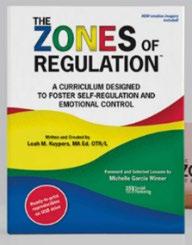
https://kentresiliencehub whole-setting-approach/school-resilience-toolkit/resources/
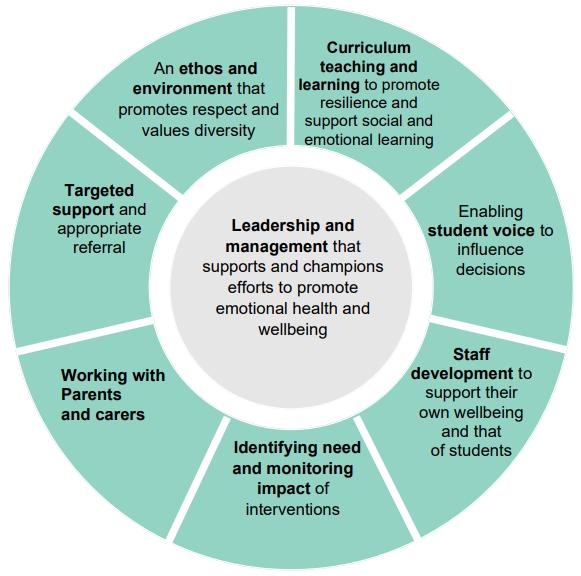
Public Health England working with the Department for Education


Anna Freud is a world-renowned mental health charity supporting children and families.
Their vision is a world where all children and young people are able to achieve their full potential. A world in which they and their families get support that is designed with their input, available at the right time, and meets their needs, so that they can develop their emotional and mental health.” Who we are | Anna Freud
“5 Steps to Mental Health and Wellbeing is a free, evidence-based framework to help you develop a wholeschool or college approach to mental health.

It's interactive, it's simple and it's free. The framework aligns with the eight principles outlined in the Department for Education and Public Health England’s whole-school approach guidance.
The 5 Steps will help you to take a considered approach to the mental health needs of pupils and staff, the importance of leadership, and the role of the community.
Any whole-school or college approach to mental health must also consider the principles of equity, diversity, and inclusion, which are woven through the 5 Steps framework.
Use the free 5 Steps action planning tool to measure your progress against each step.”
Trauma Informed Practice
www.gov.uk - working definition of trauma informed practice
https://www.youngminds.org.uk - trauma-informed-schools.pdf
Primary School resource:
“West Kent Local Children’s Partnership Groups have developed a resource and training package, to raise awareness of the impact of domestic abuse and wider adverse childhood experiences (ACEs) amongst primary age children.
This resource aims to give children a better understanding of the wide range of home and environmental experiences that can affect emotional wellbeing and resilience, through the use of animation videos and teacher-led discussions.”


https://www.kelsi.org.uk/support-for-children-and-young-people/health-andwellbeing/brighter-worlds-adverse-childhood-experiences-aces-resource
“Emotionally based school avoidance pathway for Kent.
The pathway is in line with evidence-based suggestions and research for effective working to supporting children with EBSA (previously ABSA - Anxiety Based School Avoidance) particularly offering early intervention, increased partnership working, shared awareness of push and pull factors and resources and measures to better explore the child’s voice and help parents and children feel PART of their support plans in helping them return to school.”
For more information click on the link below:
https://www.kelsi.org.uk/special-education-needs/educational-psychology/educationalpsychology-interventions
Literacy Support Assistant (ELSA)
“Emotional Literacy Support Assistants (ELSAs) plan and deliver emotional literacy programmes of support to children and young people, usually lasting 6 to 12 weeks. A programme might be designed to help a child or young person to:
• recognise and manage their emotions
• raise their self-esteem
• improve peer relationships
• recover from significant loss or bereavement
• resolve conflict effectively.
ELSAs are trained and supervised by Educational Psychologists (EPs). In order to become an accredited ELSA, six days of training and at least four supervision sessions must be completed. ELSAs need to be practising as an ELSA and attending regular supervision sessions in order to maintain their accreditation.”
For more information click on the links below
https://www.kelsi.org.uk/special-education-needs/educational-psychology/educationalpsychology-services/core-preventative-services
https://www.elsanetwork.org/


Education Endowment Foundation: Improving Social and Emotional Learning in Primary Schools
EEF Social and Emotional Learning.pdf
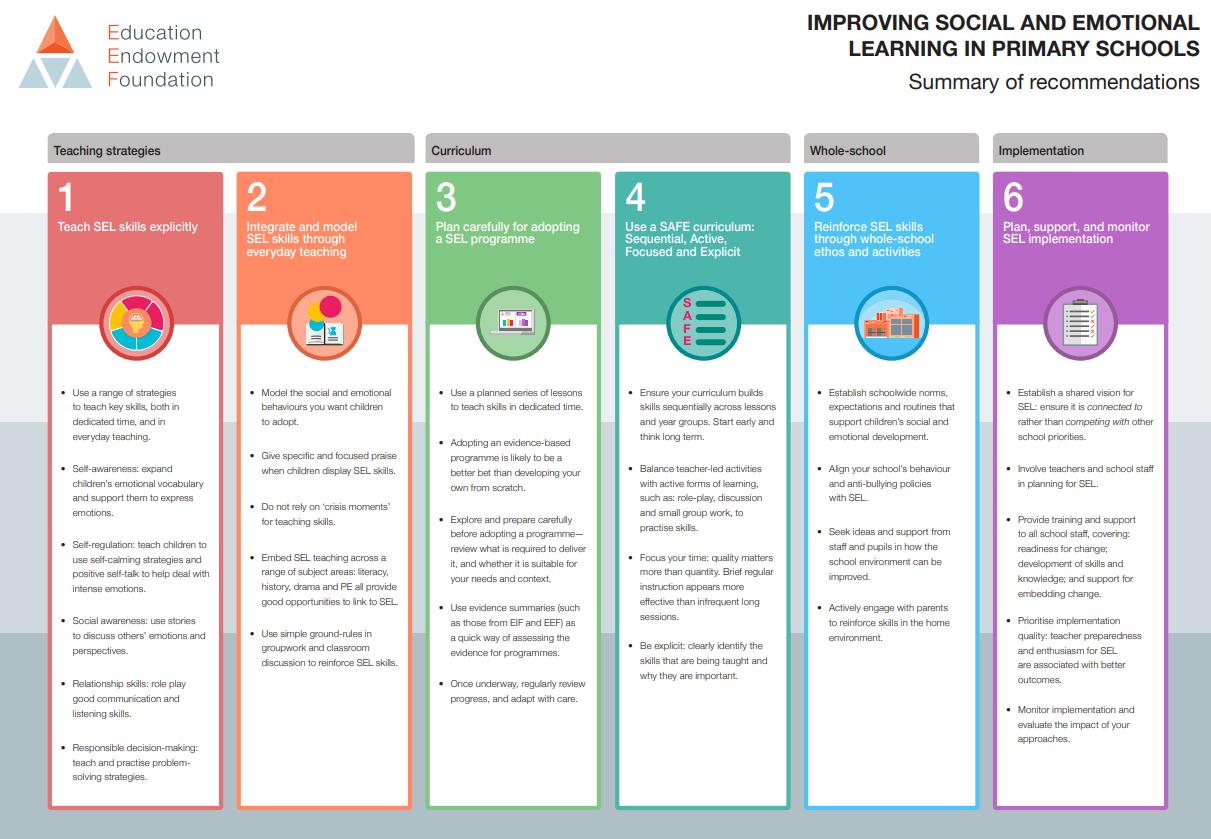
Mainstream Core Standards (page 12)
Expectations Possible Supportive Strategies
Resources are allocated appropriately to ensure additional needs are met. Quality and
A designated safe space, supervised by a key adult is available for pupils who require a place to sit during unstructured times and when they need time to reset, time to talk, deescalated their behaviour, sensory zone or if a school has one - access to the therapy dog.
• Weighted blankets
• Wobble cushions


impact of support, is scrutinised.
• Timers
• Zones of Regulation Toolkit
• Fidget toys
• Key therapy strategies recommended by professionals.
• Art therapy
• Classroom timeout card
• Relaxation and mindfulness
• Anger management
• Young Yoga
• Sensory Circuits.
Primary school age:
• https://www.healthforkids.co.uk/
• https://kentresiliencehub.org.uk/working-with-youngpeople/session-plans-activities/resources-for-specificneeds/emotional-wellbeing-support-for-primary-school-agedchildren
Whole School Setting Approach:
• https://kentresiliencehub.org.uk/working-with-youngpeople/whole-setting-approach/school-resilience-toolkit/
Specialist Teaching and Learning Service:
• https://www.kent.gov.uk/education-and-children/specialeducational-needs/types-of-send/sensory-services/specialistteaching-and-learning-services
ResearchEd: Attachment theory what do teachers need to know?
Kent Resilience Hub has a wealth of resources to directly support CYP themselves: https://kentresiliencehub.org.uk/working-with-youngpeople
Specific resources and strategies are provided to overcome potential barriers to learning. Increased use of ICT resources.
Equipment, apparatus and adapted resources are available for those pupils who need them. ICT is used to support alternatives to written recording and to promote independent learning.


To support pupils with SEMH it is important that pupils feel comfortable and safe in their school and classroom environment. Some pupils may find the school and classroom environment overwhelming or subjects that they find difficult may trigger higher levels of anxiety and reluctance to engage or attend the lesson.
Key strategies to support a pupil in classroom are as follows.
Create a calm, warm and welcoming environment – set clear expectations.
Greet the pupils at the door – know your pupils well.
Celebrate success – positivity. However, be mindful that some pupils will not wish you to communicate their accomplishments to the whole class – build their confidence by starting with 1:1 feedback.
Use pupil voice or the profile/passport you have been given – where a pupil feels safe seating in the lesson can significantly reduce anxiety levels.
Routines and consistency are important for pupils with SEMH.
Consistently enforce the school’s behaviour policy– pupils need to see that the teacher is always firm but fair.
Whenever possible warn pupils of any changes in routines for example changes to seating plans or classroom.
Plan for transitions during the lesson, whether that be content and task or moving from a written activity to a practical activity, for example in science, food technology or music.
Warn those pupils who have sensory needs of possible changes to noise levels or activities they may be taking part in.
Be observant of changes in a pupil’ body language which could indicate their heightening levels of anxiety and check in with them.
The MCS sets out expectations and possible supportive strategies for schools to embed as part of their inclusive practice. Please see below:
Mainstream Core Standards (page 11)
Expectations Possible Supportive Strategies
The physical environment is adapted to meet the needs of learners.
Ensure that the accessibility policy and plan is on the school website and that ‘reasonable adjustments’ are made accordingly to meet individual needs.
• Seek pupil voice.


• Where does the pupil prefer to sit to reduce anxiety?
• Do they require any specific resources? e.g., wobble cushion, weighted blanket, chair/table height, lighting.
• How can the classroom be made more accessible to them to reduce anxiety?
Are risk assessments and provision in place to support a pupil to access extra-curricular activities, trips and visits? Are ‘reasonable adjustments’ made?
Create an inclusive and supportive environment.
Greet pupils at the classroom door with warmth and encouragement. Know you pupils well – what they like and how they like to learn. How does their profile inform your planning?
Champion and celebrate their successes.
Identify the areas that cause anxiety for pupils and develop their confidence and self-belief – it is okay to make mistakes because this is how we learn.
Understand pupil’s needs and use a multi-sensory and adaptive approach.
Parental engagement – are parent fully involved in discussion and meetings to support their child/children in school - socially, emotionally, and academically.
Teachers and support staff are aware of sensory needs and issues that may impact on learners.
Pupil’s sensory and SEMH needs are known and taken account of when planning seating arrangements and movement breaks. Leftand right-handed pupils are able to use equipment comfortably.
Provide a pupil with a strategy to indicate when they have heightened anxiety and may wish to leave the classroom or are struggling to access their learning, e.g., red, amber, green cards that a pupil can put on the desk.
Pupils who wear glasses and/or hearing aids wear them and are seated in the optimum position. Displays are meaningful and visually accessible to reduce sensory overload.


Staff are aware of lighting in the room, e.g., use of natural light, glare from the board, use of window blinds, who is facing the light, where to stand in relation to the light.
Use of pale background and accessible font styles with good colour contrast on the interactive whiteboards. Use of good-sized clear font on worksheets and the use of off-white paper to improve access.
Staff are aware of pupils who may be sensitive to particular sounds, sights or smells and take steps to minimise the impact or remove these sensory stimuli. Where possible, improve listening conditions by using fabric on classroom wall and table displays to absorb sound.
Pupils can wear ear defenders to reduce the impact of noise.
Reasonable adjustments may be made to support a pupil’s emotional and sensory wellbeing e.g., school uniform – doing up top button or wearing a blazer.
Fix plastic buffers on chair legs to reduce the noise of scraping chairs.
Have a clear plan to support pupils whose anxiety levels will rise should the fire alarm go off.
Provide a safe space for pupils to go to should they have low mood or heightened anxiety – ensure the space is quiet and supervised by a trained member of staff.


Supporting pupils with SEMH requires the support, advice, guidance and training from the SENCO. With regards to some pupils with more complex SEMH needs, the SENCO or parents will have sought (through referrals) the support of key external professionals.
It is important that staff are provided with the most up-to-date strategies and information to support the pupil.
Some schools may commission their own school counsellors or train staff to become, for example, Mental Health First Aiders or Emotional Literacy Support Assistants (ELSAs)
Mainstream Core Standards (Page 13)
Expectations
All members of the school staff body make a positive contribution to supporting pupils with SEMH.
The use of additional adults is carefully planned with a focus on development of skills, so that learners make progress towards their targets and longer-term outcomes, and independence is promoted.
When appropriate, ensure TAs and pastoral support staff receive the same high-quality SEMH training that teaching staff receive.
Grouping/seating arrangements and additional support are used to promote independent learning as far as possible.
Strategies used in interventions are integrated into class teaching so that learners can sustain progress.
Possible training – does the school have qualitied:
• Designated Senior Lead for Mental Health (DSLMH) https://www.gov.uk/guidance/senior-mental-health-leadtraining
• Mental Health First Aiders https://www.sja.org.uk/courses/workplace-mental-healthfirst-aid
• Emotional Literacy Support Assistant (ELSA) https://www.elsanetwork.org/


• Zone of Regulation https://zonesofregulation.com/
Staff collaborate and have effective links with other relevant outside agencies and specialists.
Practitioners know when to refer for extra support or advice. The setting is aware of and regularly communicates with any other professionals who are involved with each learner. It is vital that the SENCO coordinates information sharing with teachers.
Create team around the pupil meetings to discuss concerns, share good practice and strategies.
Advice and recommendations received from other professionals is used to inform teaching and learning.
Key professionals’ advice sought and involved:
• SEN Inclusion Adviser
• Educational Psychology
• Specialist Teaching and Learning Service (STLS)
• Health professionals – CHYMPs, HI, VI, Diabetic Nurse, Occupational Therapy
• School Counsellor
• Social Services and Early Help


“High-quality teaching that is differentiated and personalised will meet the individual needs of the majority of children and young people. Some children and young people need educational provision that is additional to or different from this. This is special educational provision under Section 21 of the Children and Families Act 2014.
“Schools and colleges must use their best endeavours to ensure that such provision is made for those who need it. Special educational provision is underpinned by highquality teaching and is compromised by anything less.” (SEND Code of Practice 2015: 25).
“Persistent disruptive withdrawn behaviours do not necessarily mean that a child or young person has SEN. Where there are concerns, there should be an assessment to determine whether there are any causal factors such as undiagnosed learning difficulties with and with communication or mental health issues.” (DfE 2014a:85)
Anxiety can present in a variety of ways. A pupil could become withdrawn, refuse to engage in their learning or interact with their peers. A pupil may also display disruptive behaviour, over stimulation, increased emotions and even aggression. It is important to establish as the teacher what may be causing this behaviour.
Possible causes:
• external factors existing in the pupil’s life outside school
• prior experience of education
• self-esteem, self-belief and confidence
• Special Educational Need diagnosis
• environmental factors: classroom setting e.g., where the pupil sits
• sensory issues
• peer interaction and relationships.
Mainstream Core Standards (page 9)
Expectations
All staff are aware of the additional needs of their learners and their barriers to learning and their inclusion in school. They understand the nature and impact of these and how to respond to them.
Possible Supportive Strategies
Aspects of structured teaching are used according to pupil needs (e.g., visual timetables, clear concise instructions with written or visual prompts, particularly during transitions).
Awareness of activities that may cause anxiety for pupils. This requires careful, sensitive planning whilst providing opportunities for development of skills.


Planning incorporates more detailed specialist advice.
All staff are able to adapt their teaching and approach to provide suitable learning challenges and cater for different learning needs and styles.
Use of steps-to-success, task management boards or similar to promote independence, scaffold, and support learners.
Pupils are given time to process information before being asked to respond.
Tasks are broken down into small manageable steps. These steps are shown explicitly.
The pace and order of activities is varied to maintain interest and attention of all pupils.
Provide red, amber, green cards to enable a pupil to nonverbally communicate their understanding and levels of confidence/anxiety. This can be used as a whole class strategy (see Section 9).
Early communication to ensure pupils are aware of expectations and the curriculum model.
Modelling is used to aid understanding.
Visual/audio demonstrations and visual cues/audio commentary are used.
Key vocab is displayed with visuals.
Alternatives to written recording are used routinely.
Study skills are explicitly taught.
Pupils have access to homework clubs, or additional support with homework.
Homework is differentiated appropriately for pupils.
Interactive whiteboards are used to effectively to promote engagement and to scaffold the lesson.
All staff ensure that learners have opportunities to work in different ways, e.g., independently, in a variety of small groups and/or in pairs. Individual and/or small group sessions.
Strategies are used to actively promote independent learning, e.g., through pre-teaching, overlearning, appropriately differentiated resources.
Seating plans and groupings take account of individual needs and routinely provide opportunities for access to role-models, mixed-ability starting points, structured opportunities for conversation and sharing of ideas and access to additional adults.


Use of additional adults is planned between the teacher and additional adult to maximise their impact on learning.
Pupils understand the role of additional adults in the classroom and are supported to develop the skills required for independence.
Planning the provision for pupils in the classroom is an integral part of a teacher’s role. It is even more important when teaching pupils with SEMH who have heightened levels of anxiety and require continuity, consistency, advanced warning of change and provided with a plan/outline of what is going to be taught in in the lesson and throughout the term – for example, enabling pupils to have access to the scheme of work or curriculum guides. Pupils will need to know your expectations and how you are going to provide them with the tools to retain and recall information. Endeavouring to removing the barriers to learning and increasing a pupil’s confidence is key to supporting all pupils and especially for those with SEMH.
Embedding the advised/appropriate strategies to support a pupil in the classroom should be implemented alongside the possible approaches below. The advice and guidance communicated by the SENCO in conjunction with pupil voice or for some pupils who are working with external specialists such as CHYMPS key professional recommendations should be carefully considered and implemented as an integral part of lesson planning. Employing the graduated approach and developing this practice as part of lesson preparation will ensure the potential barriers to learning and/or possible triggers that increase a pupil’s anxiety during a lesson can be reduced. Without considering reasonable adjustments or adaptations through the implementation of high-quality teaching strategies and resources a pupil may be prevented from engaging or participating in the lesson and in some circumstances a pupil may refuse or be unable to attend the lesson.



Below is an adapted diagram created by Daniel Sobel and Sara Alston (2021:23) which can inform your planning in creating a supportive environment for your pupils. It links very closely to Nicola Crossley and Des Hewitt’s (2021) ‘10 high-quality inclusive teaching strategies’ which supports the need for a variety of high-quality practice to be present during a lesson to ensure that every pupil can access their learning and make good progress.

Adapted from The Inclusive Classroom A new approach to differentiation: Daniel Sobel and Sara Alston (2021:23)


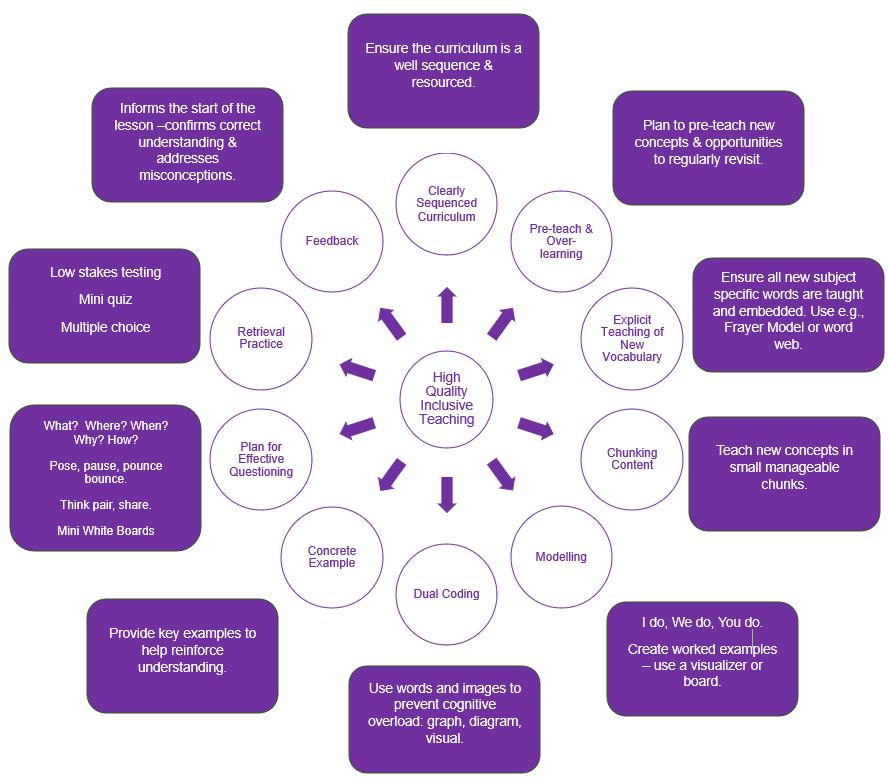
High-quality Inclusive Teaching Strategies
Adapted from Inclusion: A Principled Guide for School Leaders: Nicola Crossley and Des Hewitt (2021: Chapter 5)


Education Endowment Foundation: Five - A - Day
“Creating an inclusive environment is the most important thing a school can do. An inclusive culture is a prerequisite for an effective school: it brings happiness, a feeling of safety and being part of the community, and, of course, it impacts positively on learning, both in the classroom and beyond. It is our job to prepare pupils to flourish and feel truly included in society.”
EEF 2020:10
Know Your Pupils Well!
Using Technology
EEF Link
Use technology to support learning –visualiser. Pupils may need to use assistive technology.

Flexible Grouping EEF Link
Think carefully how you group pupils e.g., mixed starting points or similar staring points according to the activity. Enable peer support.


Greet pupils at the door - warm and welcoming. Seek information, advice, guidance and support from your SENCO.

Five - A- Day
EEF Five - A - Day video

Scaffolding EEF Link
Teacher provides temporary support. Verbal, visual, written that is gradually withdrawn.
Explicit Instruction
EEF Link
Use clear language and instructions. Regularly check for understanding.

Cognitive and Metacognitive Strategies

EEF Link
Prevent cognitive overload. Support pupils with skills to develop independent


For more information: https://educationendowmentfoundation.org.uk/education-evidence/guidancereports/send
Education Endowment Foundation: EEF Guidance-Report: Special Educational Needs in Mainstream Schools.



Alongside academic support it is paramount that high-quality pastoral support and provision is put in place to enable pupils with SEMH can successfully access both their classroom and school environments.
It is important to ensure that the SENCO provides up-to-date information and strategies to support pupils with SEMH and where necessary risk assessments are communicated to all staff. At all times, all staff must follow the school safeguarding policy and procedures.
The setting recognises, and responds to, the need for pastoral support for learners with SEND, bearing in mind the individual’s social and emotional needs and other relevant contextual circumstances.
There is a calm and purposeful climate for learning where pupils feel they belong and that their contributions are valued.
Pupils can identify an agreed safe space.
Language used in the classroom demonstrates unconditional positive regard for learners, e.g., restorative approaches.
Awareness that pupils with SEND can be vulnerable to bullying and an enhanced level of support and monitoring is in place.
PSHE is used to develop wellbeing and resilience.
Peer-awareness and sensitivity towards difference (including SEND) are raised at a whole school level.
Work is done with classes, groups and individuals regarding specific needs or conditions as appropriate.
Learners with SEND are given opportunities to work with their peers to develop their understanding of difference as appropriate.
Pupils feel safe and valued. They know that they can approach staff and that their opinions and concerns are valued.
Pupils are provided with a named adult/s or key worker as a stable point of reference when required.
Negative attitudes, beliefs and perceptions towards individuals and groups are challenged, in the classroom, the wider school and society.
Pupil voice is encouraged and acted on.


The school actively promotes the development of personal resilience and emotional wellbeing of the whole school community.
The school has achieved or is working towards the Kent School Award in Resilience and Emotional Wellbeing or similar accreditation.
Kent Resilience Hub -School Toolkit: The Kent School Award for Resilience and Emotional Wellbeing.pdf
Do they have a designated identified space to go to that is supervised by a member of staff?
Do pupils have a trusted adult who will check in with them every day and when needed?
How do you record and monitor the number of visits to the designated identified space or discussions with their key trusted adult?
How does the SENCO and pastoral teams liaise and communicate to support a pupil with SEMH?
Do both Pastoral leads and the SENCO attend key parent/carer meetings?


Task Management Board: Task management boards (doverstls.co.uk)



Frayer Model: Alex Quigley: Vocabulary Knowledge and the ‘Frayer Model’ (theconfidentteacher.com)



Example of a Word Web
Put the word in a sentence
In which lesson would you use the word?
Picture
First sound
Words with the same meaning
Write a simple definition of the word
What sort of word is it? Noun
What does it rhyme with?
How many syllables?


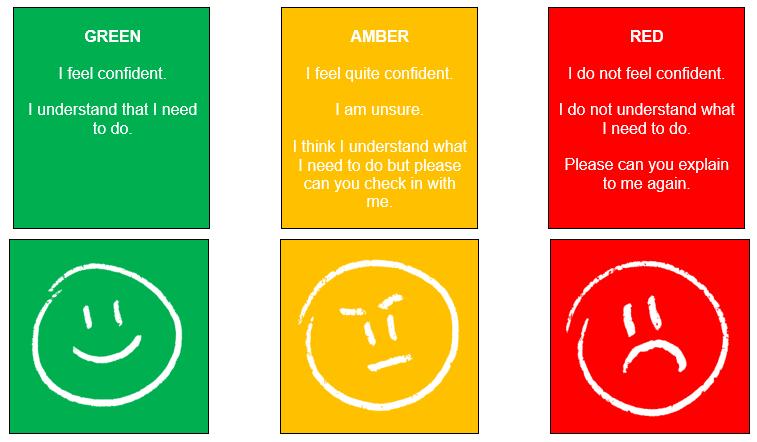


Coming soon.


Education Endowment Foundation (2021), ‘Special Educational Needs in Mainstream Schools’
EEF Special Educational Needs in Mainstream Schools Guidance Report.pdf
Education Endowment Foundation (2021), ‘Making Best Use of Teaching Assistants’: https://educationendowmentfoundation.org.uk/educationevidence/guidance-reports/teaching-assistants
KCC – ‘A Countywide Approach to Inclusive Education’ – CATIE (2024) A Countywide Approach to Inclusive Education.pdf
KCC - KELSI: https://www.kelsi.org.uk/special-education-needs/special-educationalneeds
KCC Mainstream Core Standards : KCC Send Mainstream Core Standards
Kent Resilience Hub: https://kentresiliencehub.org.uk/
Nasen Inclusion: Crossley, N., Hewitt, D. (2021), ‘A Principled Guide for School Leaders’ David Fulton Publication
Nasen Teacher Handbook: SEND, Embedding inclusive practice: Nasen Teacher Handbook SEND - January 2024.pdf
Brooks.R, (2019), ‘The Trauma and Attachment Aware Classroom’. Jessica Kinglsey Publishers
Robins.J, Dempster.K (2021), ‘The four Pillars of Parental Engagement’. Independent thinking press
Sobel, D and Alston, S (2021), ‘The Inclusive Classroom: an approach to differentiation’. Bloomsbury.